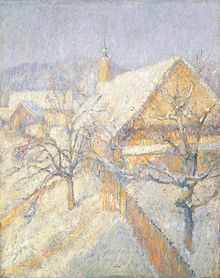Rihard Jakopič

Rihard Jakopič (12 April 1869 – 21 April 1943) was a
Life

Rihard Jakopič was born in Krakovo, a suburb of Ljubljana, the capital of Carniola in the Austria-Hungary, now Slovenia. His father, Franc Jakopič, was a well-situated tradesman with agricultural goods. His mother was Neža, née Dolžan. Rihard was the youngest of eight children.[1]
Jakopič studied at the
Jakopič died at his home in Ljubljana at 1:45 pm on 21 April 1943 after a long and difficult illness. A wake was held at his residence at New Square (Novi trg) no. 2, and he was buried at Holy Cross Cemetery (now Žale Cemetery) on 23 April 1943 after a ceremony at 3:30 pm at Saint Joseph's Chapel.[2]
Legacy
This section needs expansion. You can help by adding to it. (May 2012) |

Over 1200 paintings and 650 drawings by Jakopič have been preserved.
In Ljubljana, Jakopič established the Slovene School of Impressionist Drawing and Painting, the predecessor of the
Commemoration
In 1965 a primary school in Šiška was named after him. Since 1969, the Jakopič Award, the highest Slovenian award in fine arts, is presented annually. In 1970–72, a statue of Jakopič by Bojan Kunaver was erected on the original site of the pavilion. In 1979, a new Jakopič Gallery (Slovene: Galerija Jakopič) opened at Slovene Street (Slovene: Slovenska cesta) in Ljubljana. After Slovenia declared independence from Yugoslavia, Jakopič was portrayed by Rudi Španzel on the 100 Slovenian tolar banknote, in circulation from October 1991 until the introduction of euro in January 2007.[3]
Selected works

- Sončni breg (Sunny Hillside) (1903), National Gallery, Ljubljana
- Breze v jeseni (Birches in Autumn) (1903), National Gallery, Ljubljana
- Kamnitnik v snegu (Kamnitnik in the Snow) (1903), National Gallery, Ljubljana
- Sončni breg (Sunny Hillside) (1903), National Gallery, Ljubljana
- Zima (Winter) (1904), National Gallery, Ljubljana
- Pri svetilki (By the lamp) (1904), National Gallery, Ljubljana
- Študija sonca (A Study of the Sun) (1905), National Gallery, Ljubljana
- Križanke (1909), National Gallery, Ljubljana
- Spomini (Memories) (1912), National Gallery, Ljubljana
- Zeleni pajčolan (The Green Veil) (1915), National Gallery, Ljubljana
- Večer na Savi (Evening on the Sava River) (1926), National Gallery, Ljubljana
- Slepec (Blind man) (1926), National Gallery, Ljubljana
References
- ^ ISBN 978-961-268-001-5.
- ^ "Mojster slovenskih slikarjev akademik R. Jakopič umrl." 1943 Slovenec 71(92) (23 April): 2, 4. (in Slovene)
- ^ Šiška, Marko (January 2012). "Twenty Years of National Currency". Www.ukom.gov.si. Government Communication Office, Republic of Slovenia. Archived from the original on 2013-10-22.
External links
- Slovene Early Modernism: Rihard Jakopič. National Gallery of Slovenia site. Retrieved 8 May 2012.
